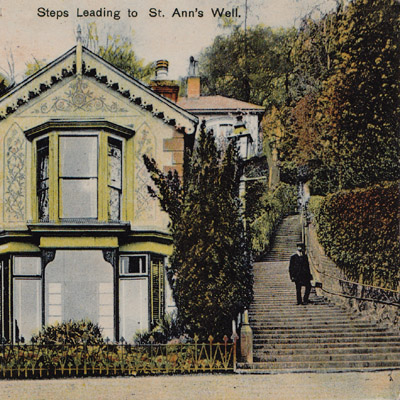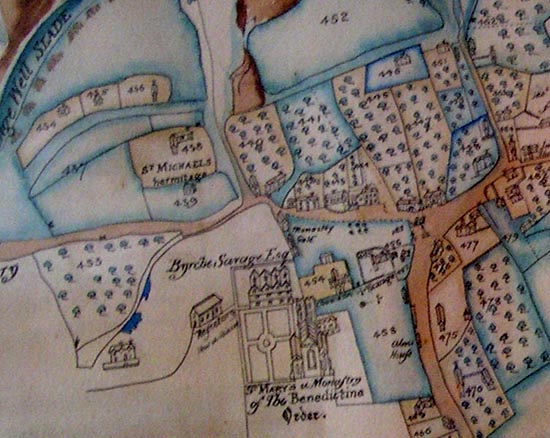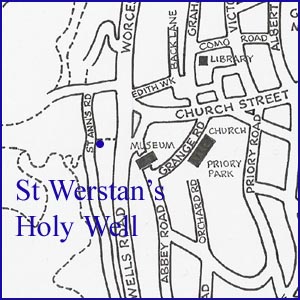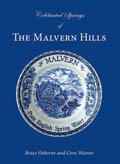
| 
|


St Werstan's Holy Well
NGR 77378 45830
Site Number: C124
By Bruce Osborne and Cora Weaver (C) 2012
Area 1. Malvern Town Centre Springs and Wells
Malvern Hills, England
Description: there is an occasional small outfall from a pipe, though the exact location of St Werstan's Well is lost.
The site west of Rose Bank Gardens is of great antiquity and importance to Malvern. At the northern end of the gardens are the 99 steps. This is an ancient processional way going back to medieval times, linking a hermitage with the Priory or its predecessor Werstan's chapel. The location can be determined from the 1744 estate map where the building survives as St Michaels Hermitage.

The springs that have an easterly aspect were anciently regarded as of special merit. Their purity and medicinal qualities were in part derived from the morning sun rising and shining upon them, thus preventing any bad effects from the morning "damps". This particularly applied in the summer season and would be a consideration when Werstan determined the siting of his hermitage.[4]


In the year 2005 the St Werstan Award was created, honouring the martyr's name, This is in recognition of the lasting impact that he had on Malvern when pioneering the first religious settlement in the locality of the present day St Ann's Well. It is fitting that his name is being linked with this scheme to encourage enhancement of Malvern's water heritage. The Award is a public recognition of outstanding endeavour in the conservation or renovation of Malvern springs and wells and their immediate environment. The award is administered by the Friends of Malvern Springs and Wells and is in conjunction with Coca-Cola Malvern The Original English Water. Click the logo above to find further details of the awards.
Illustrations:
1. The 99 Seps, formerly a processional way between the Priory and St Werstan's hermitage, now part of Rosebank Gardens.
4. The Abbey Gateway and St Werstan's oratory, later dedicated to St Michael, higher on the hills above the Priory where the waters from St Ann's Well valley would have made this a good place to reside in medieval times.
[1] Southall, M (1825) A Description of Malvern. p.51.
[2] Norman May's Guide to Malvern, Norman May & Co Ltd (1895), p14.
[3] Osborne B E. Weaver C W. The Illumination of St Werstan the Martyr, 2007.
[4] Chambers J. A General History of Malvern 1817. p.115.

Website: Click Here
SUPPLEMENTARY INFORMATION

Celebrated Springs of
THE MALVERN HILLS
 A definitive work that is the culmination of 20 years researching the springs and wells of the Malvern Hills, published by Phillimore. This is the ideal explorers guide enabling the reader to discover the location and often the astounding and long forgotten history of over 130 celebrated springs and wells sites around the Malvern Hills. The book is hard back with dust cover, large quarto size with lavish illustrations and extended text. Celebrated Springs contains about 200 illustrations and well researched text over a similar number of pages, together with seven area maps to guide the explorer to the locations around the Malvern Hills. It also includes details on the long history of bottling water in the Malvern Hills.
A definitive work that is the culmination of 20 years researching the springs and wells of the Malvern Hills, published by Phillimore. This is the ideal explorers guide enabling the reader to discover the location and often the astounding and long forgotten history of over 130 celebrated springs and wells sites around the Malvern Hills. The book is hard back with dust cover, large quarto size with lavish illustrations and extended text. Celebrated Springs contains about 200 illustrations and well researched text over a similar number of pages, together with seven area maps to guide the explorer to the locations around the Malvern Hills. It also includes details on the long history of bottling water in the Malvern Hills.
Written by Bruce Osborne and Cora Weaver, this book is available on-line for £15.00 (delivered UK) - click Malvern Bookshop on the green panel top left. Alternatively send a cheque payable to Cora Weaver with your name and address to 4 Hall Green, Malvern, Worcs. WR14 3QX.
1) TOPOGRAPHICAL LOCATION:
Malvern Hills - arguably Britain's original National Park
2) LANDSCAPE:
Rolling Countryside3) INFORMATION CATEGORY:
A Spring, Spout, Fountain or Holy Well Site4) MALVERN SPRING OR WELL SITE DETAILS:
1 SPLASH - Lost - Nothing Much To See
5) GENERAL VISITOR INFORMATION:
Access On FootOn Private Property


